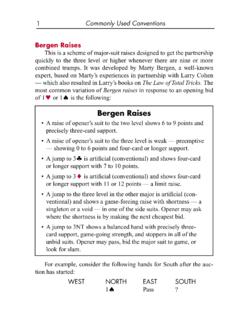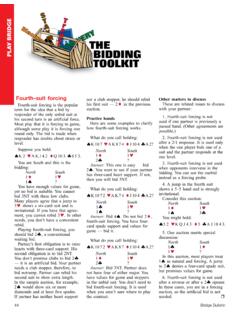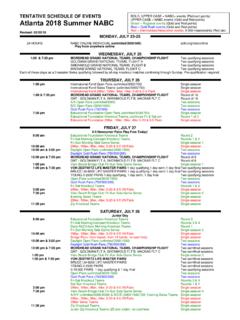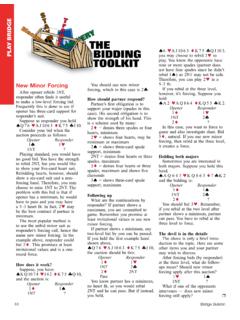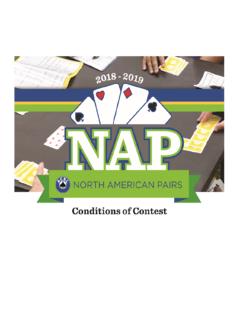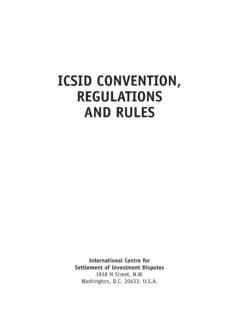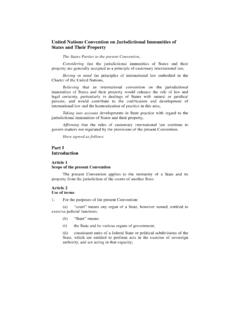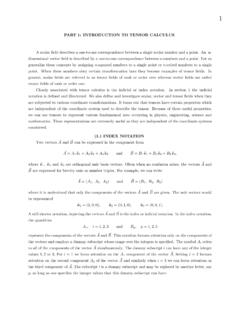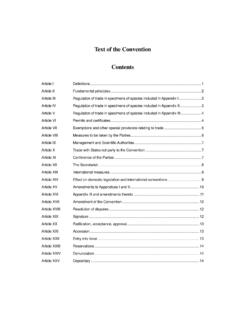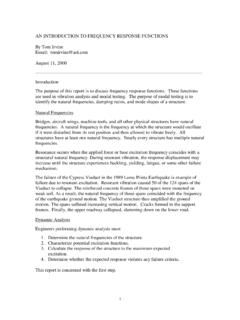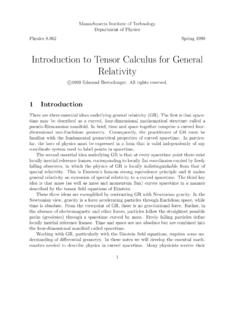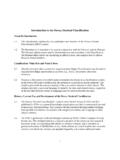Transcription of ACBL Convention Charts Introduction
1 ACBL Convention Charts 20 November 2018. Introduction The four new Convention Charts are listed in order from least to most permissive: the Basic chart , Basic+ chart , Open chart , and Open+ chart . The Basic and Basic+ Charts are intended for limited master point events. These Charts are written in manner similar to the old Charts -- by listing permitted methods. The Open and Open+ Charts are intended for events with no masterpoint limits (or high limits). In contrast to the Basic and Basic+ Charts , methods are generally allowed unless they are expressly prohibited within the chart . A comprehensive Definitions section is included In addition to the Charts . Any word that is capitalized on a chart is included in the Definitions section. An Examples section follows the Charts for cases where a rule might be ambiguous. Both the Definitions and the Examples should be included with the Charts . Any Definition or chart Rule marked with three asterisks (**) has 1 or more examples in the Example section.
2 chart Usage Tournaments Pair Events and non-Bracketed Team Events Basic chart : Applies in any event where the upper limit per player is 750 or less. Basic+ chart : Applies in any event where the upper limit per player is 3000. Open chart : At a Sectional: applies in any event with no masterpoint limit, and any event with a masterpoint limit above 3000;. At a Regional (including regional events at an NABC): applies in any 1-session event with no masterpoint limit (includes Side Series);. applies in any restricted event with a masterpoint limit above 3000;. applies in any 2-session event with no masterpoint limit if there is no 2- session event of the same type with a masterpoint limit on the same day Nationally Rated Events: applies in any NABC event with an upper masterpoint limit between 3001 and 6000. Open+ chart : At a Regional (including regional events at an NABC): applies in any 3+-session event with no masterpoint limit.
3 Applies in any 2-session event with no masterpoint limit as long as there is a 2-session event of the same type with a masterpoint limit on the same day Nationally Rated Events: applies in any NABC event with no masterpoint limit, and any NABC event with an upper masterpoint limit above 6000. Bracketed Events A single bracket event always uses the Open chart . For bracketed events with more than one bracket, the Open chart is used in most brackets with these exceptions: Basic chart : Any bracket where the highest team averages less than 750 masterpoints per player;. Basic+ chart : Any bracket where the highest team averages 751 to 1500 masterpoints per player;. Open+ chart : Top bracket (regardless of team masterpoint holdings), and any other bracket where the lowest team averages more than 3000 masterpoints per player. In all types of events, when the directors allow a team to play in a higher bracket than its masterpoint holding would qualify the team for, that team's masterpoint total is ignored in determining which chart applies.
4 Club Games The Open chart is recommended for most open club games. Particularly advanced clubs may prefer to use the Open+ chart , while clubs that mainly cater to newer players may prefer the Basic+ chart . The Basic and Basic+ Charts are recommended for masterpoint restricted games at clubs. Pre-alerts and Written Defenses Two classes of methods are particularly difficult to defend against, and these methods are allowed only in events governed by the Open+ chart , and then only in segments of six boards or longer. These methods, based on #3 or #7 of the Opening Bids section of the Open+ chart , require both a pre-alert and a written defense. Official ACBL defenses must be provided when possible. In the event that a Convention does not yet have an official ACBL defense, the pair must, before using it in an ACBL sanctioned game: Submit a full description of the Convention and a proposed defense to the ACBL. committee for approval.
5 The defense must be provisionally approved. A method is provisionally approved if an acknowledgement receipt was sent by the ACBL upon submission and either: (a) the committee sends an email granting provisional approval;. or (b) it was submitted at least 30 days before the ACBL sanctioned event in which it is used and the committee has not rejected it; and Provide the submitted defense to any opponents. It is recommended that any new Convention and written defense be posted online for public comment. Note: For any method for which a written defense is required, the opposing pair may use their own defense rather than the one provided. The defending pair may refer to a pre-written copy of their own defense. Convention Charts . Definitions A group of four numbers separated by equal signs (=) denotes an exact suit distribution. For example: 5=4=3=1 denotes five spades, four hearts, three diamonds, and one club. A group of four numbers separated by hyphens (-) denotes any of the exact distributions matching that general pattern.
6 For example: 4-3-3-3 represents: 4=3=3=3 or 3=4=3=3 or 3=3=4=3 or 3=3=3=4. Definitions #1-4 below have specific meanings that may vary from commonly understood meanings or may not have previously been defined. Definitions #5 and higher likely match common understandings of the term, but are still defined here for specificity and clarity. Definitions #5 and higher appear alphabetically. 1. Hand strength: a. Weak : A hand that contains less than Near Average Strength. b. Near Average Strength : A hand that has at least 8 HCP or meets the Rule of 17 . c. Average Strength : A hand that has at least 10 HCP or meets the Rule of 19 . d. Strong : A hand that contains: i. at least 15 HCP; or ii. at least 14 HCP and meets the Rule of 24 . iii. at least 5 Control Points and is within one trick of game assuming suits break evenly among the other hands. e. Very Strong : A hand that contains: i. at least 20 HCP; or ii. at least 14 HCP and is within one trick of game assuming suits break evenly among the other hands.
7 Iii. at least 5 Control Points and is within one trick of game assuming suits break evenly among the other hands. 2. ** Natural : a. Any opening bid, response, or overcall in a suit at the one-level showing 4 or more cards in the suit bid, except as provided in 2(f) and 2(g). b. Any opening bid at the two-level or higher showing 5 or more cards in the suit bid. c. Any response or rebid in a minor at the two-level or higher showing 3 or more cards in the suit bid d. Any response or rebid in a major at the two-level or higher showing 4 or more cards in the suit bid. e. Any suit overcall at any level showing 4 or more cards in the suit bid. f. A 1C opening bid showing 3 or more clubs. This opening may also include exactly 4=4=3=2 shape. g. A 1D opening bid, overcall, or response showing 3 or more diamonds. h. A NT opening bid or overcall that contains no voids, no more than one singleton, which must be an ace, king, or queen, and that does not contain 10 or more cards in two suits combined.
8 I. A call is still Natural if it also shows distribution in another suit. j. A pass, double, or redouble is Natural if it suggests the current contract as the final contract. k. After the opening bid any bid is Natural if it suggests the contract bid as the final contract. 3. ** Quasi-Natural : a. A minor suit bid that is either Natural or shows a pattern that meets the definition of a Natural NT opening. b. Any opening bid at the two-level or higher showing 4 or more cards in the suit bid. 4. ** Purely Destructive Initial Action : An opening bid or an overcall that satisfies none of the following: a. 4+ cards in a known suit. b. 5+ cards in one of two possible suits. c. 5+-4+ distribution in any two suits. d. An either/or combination of any two of a, b, or c (which may be the same option twice). e. A Three-suited hand. f. At least Average strength. g. Any Natural or Quasi-Natural opening bid. ------------------------ 5.
9 Advancer : Overcaller's partner. 6. Agreement : Partnership understandings of methods adopted by the partnership that are reached explicitly by discussion or implicitly through the mutual experience or awareness of the players. This applies to all calls, allowed and disallowed. 7. Artificial : Any call that is not Natural or Quasi-Natural. 8. Balancing Seat : After the bidding has been opened, a player who would end the auction if that player passed. 9. Bid : A call that names a level and a denomination (suit or notrump). 10. Call : Any bid, pass, double, or redouble. 11. Control Bid : A bid showing first or second round control of a suit. 12. Control Points : An alternate evaluation method where an Ace=2 and a King=1. 13. Cuebid : A bid of a suit that an opponent has bid Naturally or Quasi-Naturally or a suit in which an opponent has shown 4 or more cards. 14. Direct Overcall : An immediate overcall by the left hand opponent of Opener.
10 15. ** Encrypted Signal : An encrypted signal is one where the ordering of the cards for the signal is dependent on information known only to the defenders. It is not an encrypted signal to have the type of signal (attitude, count, suit preference) dependent on information known only to the defenders. 16. Forcing : A call that, by partnership Agreement, may not be passed if the intervening opponent passes. 17. High Card Points (HCP) : The total number of points in a hand based on honors, counting 4 for an Ace, 3 for a King, 2 for a Queen, and 1 for a Jack. 18. Invitational : A hand sufficiently strong to indicate that partner should bid game unless partner has a minimum. 19. Length : Unless otherwise specified, showing Length in a suit or showing a suit . means at least four cards in the suit. 20. Opener : The first player to make a bid in the auction. 21. Overcall : The first bid made by the pair that does not consist of Opener and Responder.
